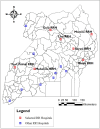Determinants and barriers of modern family planning uptake among postpartum mothers at selected regional referral hospitals in Uganda: a cross-sectional study
- PMID: 41074126
- PMCID: PMC12512698
- DOI: 10.1186/s12978-025-02137-4
Determinants and barriers of modern family planning uptake among postpartum mothers at selected regional referral hospitals in Uganda: a cross-sectional study
Abstract
Background: Postpartum family planning (PPFP) is important in reducing the risk of complications associated with closely spaced pregnancies. Family planning (FP) programmes usually promote the use of modern methods rather than traditional methods as the latter have a higher failure rate. However, only 28% of postpartum women in Uganda use modern FP. We identified determinants and barriers of modern FP uptake among postpartum mothers at selected regional referral hospitals (RRH) in Uganda in October 2023.
Methods: We conducted a cross-sectional study among 499 postpartum mothers aged 18-49 years, and attending immunization clinics in seven selected RRH in October 2023. We defined modern FP uptake as use of a contemporary contraception method: condoms, intrauterine devices (IUD), male or female sterilization, injectables, oral contraceptives and implants. We conducted interviews to collect data on sociodemographic characteristics, reproductive health and obstetric history and modern FP uptake. We summarized participant characteristics using frequency distributions, and identified determinants of uptake using modified Poisson regression.
Results: Among 499 postpartum mothers, most were aged 25-34 years (45%), unemployed (33%), and had attained secondary education (45%). The majority had heard about modern FP (85%), received counselling regarding PPFP (64%), and were using modern FP methods (46%). Mother being formally employed (aPR = 1.5, 95% CI: 1.1-2.1), having an employed partner (aPR = 4.14, 95% CI: 1.31-13.05), exclusive breastfeeding (aPR = 0.8, 95% CI: 0.65-0.99), receiving counselling on FP (aPR = 2.9, 95% CI: 2.1-4.02) were associated with modern FP uptake. Among 270 mothers who did not take up modern FP, spouse not being around (17%), fear of side effects (13%), and not being decided on method (10%) were the commonest reasons for non-uptake of modern FP.
Conclusion: Uptake of modern FP among postpartum mothers was suboptimal given that all postpartum mothers should be using FP. Mother being employed, partner employment, exclusive breastfeeding and receiving counselling on FP were associated with uptake of modern FP. Spouse not being around, fear of side effects and not being decided on FP method, were the commonest reasons for non-uptake of modern FP. We recommended intensifying FP counseling services in addition to health education for mothers and their partners on the benefits of using modern FP to improve modern FP uptake among postpartum mothers.
Keywords: Barriers; Factors; Modern FP; Postpartum mothers; Uganda; Uptake.
© 2025. The Author(s).
Conflict of interest statement
Declarations. Ethics approval and consent to participate: The Office of the Associate Director for Science, US-Centers for Disease Control and Prevention (CDC)-Uganda, and the US-CDC human subjects review board determined that this study was non-research aimed at informing MoH policy and actions towards improved PPFP uptake. The Uganda Ministry of Health and respective RRHs provided administrative clearance before execution of this study. We sought written consent from participants to take part in the study. We ensured confidentiality and privacy by de-identifying the data collected and used password protected computers only accessed by the study team to store the data. Consent for publication: Not applicable. Competing interests: Uthors declare no competing interests.
Figures
References
-
- Yemane TT, Bogale GG, Egata G, Tefera TK. Postpartum family planning use and its determinants among women of the reproductive age group in low-income countries of Sub-Saharan Africa: a systematic review and meta-analysis. Int J Reprod Med. 2021;2021:1–14. 10.1155/2021/5580490.
-
- Demie TG, Demissew T, Huluka TK, Workineh D, Libanos HG. Postpartum family planning utilization among postpartum women in public health institutions of Debre Berhan Town, Ethiopia. J Women’s Health Care. 2018. 10.4172/2167-0420.1000426.
MeSH terms
LinkOut - more resources
Full Text Sources
Medical
Miscellaneous



